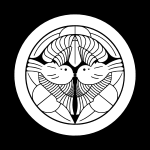Uesugi Kagekatsu
Uesugi Kagekatsu (上杉 景勝, 8 January 1556 – 19 April 1623) was a Japanese samurai daimyō during the Sengoku and Edo periods.[1]
Uesugi Kagekatsu 上杉 景勝 | |
|---|---|
 | |
| Lord of Yonezawa | |
| In office 1601–1623 | |
| Succeeded by | Uesugi Sadakatsu |
| Lord of Aizu | |
| In office 1598–1601 | |
| Preceded by | Gamō Hideyuki |
| Succeeded by | Gamō Hideyuki |
| Personal details | |
| Born | January 8, 1556 Echigo Province, Japan |
| Died | April 19, 1623 (aged 67) Yonezawa, Japan |
| Nationality | Japanese |
| Mother | Aya-Gozen |
| Father | Nagao Masakage |
| Relatives | Uesugi Kenshin (adoptive father) Uesugi Kagetora (brother-in-law) |
| Military service | |
| Allegiance | |
| Unit | |
| Battles/wars | Battle of Tedorigawa Siege of Otate Siege of Uozu Siege of Hachiōji Siege of Hachigata Siege of Odawara Kunohe Rebellion Korean Campaign Siege of Shiroishi Siege of Hasedō Siege of Osaka |
Early life and rise

Kagekatsu was the son of Nagao Masakage, the head of the Ueda Nagao clan and husband of Uesugi Kenshin's elder sister, Aya-Gozen. After his father died, he was adopted by Kenshin. His childhood name was Unomatsu.
In 1577, He participated in Battle of Tedorigawa. Upon Kenshin's death in 1578, Kagekatsu battled Kenshin's other adopted son Uesugi Kagetora for the inheritance, defeating him in the 1578 Siege of Otate. He forced Kagetora to commit seppuku, and became head of the Uesugi clan. Kagekatsu married Takeda Katsuyori's sister (Takeda Shingen's daughter) after the Siege of Otate.
Conflict with Oda
By 1579, Kagekatsu had gained the upper hand and forced Kagetora to commit suicide. This bloody division allowed Oda Nobunaga's generals (headed by Shibata Katsuie) to conquer the Uesugi's lands in Kaga, Noto, and Etchu.
In 1582, Kagekatsu led an army into Etchu and was defeated by Oda forces at the Battle of Tenjinyama. He hastily returned to Echigo when he learned that Oda general Mori Nagayoshi had raided Echigo in his absence. When Oda laid Siege of Uozu castle in Etchu, in the course of which a number of important Uesugi retainers were killed, Kagekatsu's fortunes appeared bleak.
Kagekatsu sent a letter to Satake Yoshishige, his allies. It's like a suicide note.[2]
- Please don't worry about us.
- I was born in a good era. We will fight against over 60 provinces of Japan with only this Echigo province.
- If we survive, I'll become an unmatched hero. Even if we are destroyed, my name will go down in history.
Uozu castle fell on June 3, 1582, and Oda Nobunaga would die eighteen days later, in Kyoto. The Uesugi were given a reprieve with the death of Nobunaga shortly afterwards.
Service under Hideyoshi
Kagekatsu made friendly overtures to Toyotomi Hideyoshi, and attacked Shibata Katsuie's northern outposts during the Shizugatake Campaign (1583) and went on to support Hideyoshi during the Komaki Campaign (1584), in which he played a limited role by launching a foray into Shinano. As a general under Toyotomi Hideyoshi, Kagekatsu took part in the Odawara campaign 1590 and Korea campaigns 1592-1598, and rise to prominence to become a member of the Council of Five Elders. Originally holding a 550,000 koku fief in Echigo Province, Kagekatsu received the fief of Aizu, worth a huge 1.2 million koku when Hideyoshi redistributed holdings in 1598. After Hideyoshi's death, that year, Kagekatsu then allied himself with Ishida Mitsunari, against Tokugawa Ieyasu, as the result of some political dispute.
Sekigahara Campaign
The Sekigahara Campaign 1600 can be said to have begun, at least in part, with Kagekatsu, who was the first daimyō to plan a revolt against the Tokugawa. He built a new castle in Aizu, attracting the attention of Ieyasu, who ordered him to Osaka, to explain his conduct, Kagekatsu refused, and Tokugawa began plans to lead a 50,000 man army north against him. Ishida and Uesugi hoped to occupy Tokugawa Ieyasu with this fighting in the north, distracting him from Ishida Mitsunari's attacks in and around Osaka. Anticipating this, Ieyasu remained in Osaka to engage Mitsunari; his generals Mogami Yoshiaki and Date Masamune would fight Kagekatsu in Tōhoku (northern region Honshū, Japan's main island). Kagekatsu had intended to move his force south, attacking the Tokugawa from the north-east while Ishida attacked from the west, but he was defeated very early in the campaign, at his castle in Siege of Shiroishi.
Service under Tokugawa
Declaring his allegiance to Tokugawa following his defeat in Sekigahara campaign, Kagekatsu became a tozama (outsider) daimyō; he was given the Yonezawa han, worth 300,000 koku, in the Tōhoku region. Kagekatsu fought for the Tokugawa shogunate against the Toyotomi clan in the Osaka Campaign 1614-1615.
See also
- Yamatorige - sword wielded by Kagekatsu
- Uesugi clan
- Uesugi Kenshin
- Naoe Kanetsugu
References

- Turnbull, Stephen R. (2013). Samurai Armies 1467–1649, p. 191.
- "上杉景勝". Touken World. Retrieved June 30, 2020.
Further reading
- Frederic, Louis (2002). Japan Encyclopedia. Cambridge, Massachusetts: Harvard University Press.
- Sansom, George (1961). A History of Japan: 1334–1615. Stanford, California: Stanford University Press.
- Turnbull, Stephen (1998). The Samurai Sourcebook. London: Cassell & Co.
| Preceded by Uesugi Kenshin |
Uesugi family head 1580–1623 |
Succeeded by Uesugi Sadakatsu |